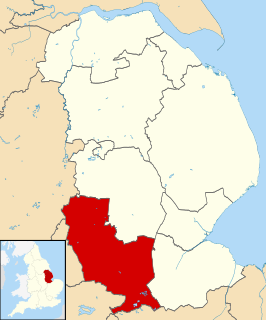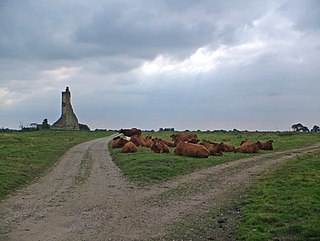
Lincoln is a cathedral city, non-metropolitan district, and the county town of Lincolnshire, England. The Lincoln district had a 2012 population of 94,600. The 2011 census gave the urban area of Lincoln, including North Hykeham and Waddington, a population of 115,000. Roman Lindum Colonia developed from an Iron Age settlement on the River Witham. Landmarks include Lincoln Cathedral – English Gothic architecture, for over 200 years the world's tallest building – and the 11th-century Norman Lincoln Castle. The city hosts the University of Lincoln, Bishop Grosseteste University, Lincoln City FC and Lincoln United FC. Lincoln is the largest settlement in Lincolnshire with the towns of Grimsby second largest and Scunthorpe third.

Grantham is a market and industrial town in the South Kesteven district of Lincolnshire, England, straddling the London–Edinburgh East Coast Main Line and the River Witham and bounded to the west by the A1 north–south trunk road. It lies some 23 miles (37 km) south of the county town, Lincoln, and 22 miles (35 km) east of Nottingham. The population in 2016 was put at 44,580. Grantham was the birthplace of the UK Prime Minister Margaret Thatcher. Isaac Newton was educated at the King's School. The town was the workplace of the UK's first female police officer, Edith Smith in 1914. The UK's first running diesel engine was made there in 1892 and the first tractor in 1896. Thomas Paine worked there as an excise officer in the 1790s.

South Kesteven is a local government district in Lincolnshire, England, forming part of the traditional Kesteven division of the county. It covers Grantham, Stamford, Bourne and Market Deeping. The 2011 census reports 133,788 people at 1.4 per hectare in 57,344 households.

North Kesteven is a local government district in the East Midlands. Just over 100 miles (160 km) north of London, it is east of Nottingham and south of Lincoln. North Kesteven is one of seven districts in Lincolnshire, England and is in the centre of the county. Its council, North Kesteven District Council, is based in Sleaford in the former offices of Kesteven County Council. Notable settlements in the district include North Hykeham, Sleaford, Metheringham, Waddington and Cranwell.

University of East London (UEL) is a public university located in the London Borough of Newham, London, England, based at three campuses in Stratford and Docklands, following the opening of University Square Stratford in September 2013. The university's roots can be traced back to 1892 when the West Ham Technical Institute was established. It gained university status in 1992.

The University of Lincoln is a public research university in Lincoln, England, with origins back to 1861. It gained university status in 1992 and its present name and structure in 2001. The main campus is adjacent to Brayford Pool - a site of urban regeneration since the 1990s, with satellite campuses in Riseholme, Lincolnshire – the Lincoln Institute for Agri-food Technology – and an additional campus at Holbeach, housing the National Centre for Food Manufacturing (NCFM). Annual graduation ceremonies take place in Lincoln Cathedral.

Bath Spa University is a public university in Bath, England, with its main campus at Newton Park, about 3+1⁄2 miles (5.6 km) west of the centre of the city. The university has other campuses in the city of Bath, and one at Corsham Court in Wiltshire.

Bishop Grosseteste University (BGU) is one of two public universities in the city of Lincoln, England. BGU was established as a teacher training college for the Diocese of Lincoln in 1862. It gained taught degree awarding powers in 2012 and was granted full university status on 3 December 2012. It has around 2,300 full-time students enrolled on a variety of programmes and courses.

The Priory Academy LSST is a co-educational partially-selective academy school and teaching school situated on Cross O'Cliff Hill, Lincoln, Lincolnshire, England. It specialises in science, technology and teaching, and is the lead school of the Lincolnshire Teaching Schools Alliance. It is also the lead member of The Priory Federation of Academies.
Glenn Paul Howells is a British architect and a director and founder of Glenn Howells Architects.

The University of Bedfordshire is a public research university with campuses in Bedfordshire and Buckinghamshire, England. The University has roots from 1882, however, it gained university status in 1993 as the University of Luton. The University changed its name to the University of Bedfordshire in 2006 by the approval of the Privy Council, following the merger of the University of Luton and the Bedford campus of De Montfort University.

The College of Fine and Applied Arts (FAA) is a multi-disciplinary art school at the University of Illinois at Urbana–Champaign.

The Lincolnshire Echo is a weekly British regional newspaper for Lincolnshire, whose first edition was on Tuesday 31 January 1893, and is published every Thursday. It is owned by Trinity Mirror and it is distributed throughout the county.

The Engine Shed is a music and entertainment venue at the University of Lincoln in Lincoln, Lincolnshire, England, and is operated by the University of Lincoln Students' Union. The venue comprises three areas: The Engine Shed, which is the main hall; The Platform, which is a smaller floor overlooking the main hall; and Towers, which is a sports bar serving food and drink split over two floors.

Kirkstead is an ancient village and former parish on the River Witham in Lincolnshire, England. It was amalgamated with the civil parish of Woodhall Spa in 1987.

High Bridge carries the High Street across the River Witham in Lincoln in eastern England. It is the oldest bridge in the United Kingdom which still has buildings on it. The bridge was built about 1160 AD and a bridge chapel was built dedicated to Thomas Becket in 1235 on the east side of the bridge. The chapel was removed in 1762. The current row of timber framed shops on the west side of the bridge date from about 1550. The two upper storeys of the shops are jettied forward and at the corners there are carved figures of angels. The shops were partly dismantled and re-erected in 1901–02 under the supervision of the Lincoln architect William Watkins.

The New York Public Library for the Performing Arts, Dorothy and Lewis B. Cullman Center, at 40 Lincoln Center Plaza, is located in Manhattan, New York City, at the Lincoln Center for the Performing Arts on the Upper West Side, between the Metropolitan Opera House and the Vivian Beaumont Theater. It houses one of the world's largest collections of materials relating to the performing arts. It is one of the four research centers of the New York Public Library's Research library system, and it is also one of the branch libraries.

The Seymour Centre is a multi-purpose performing arts centre within the University of Sydney in the Australian city of Sydney. It is located on the corner of City Rd and Cleveland St in Chippendale, just south-west of the city centre.
Lincoln Castle Academy is a secondary school with academy status located on the north side of the historic city of Lincoln in Lincolnshire, England. It is situated a couple of miles due north of Lincoln Castle, and just west of the Ermine Street Roman road heading north out of Lincoln towards the River Humber.

The following is a timeline of the history of the city of Lincoln, the county town of Lincolnshire in the East Midlands of England.




















